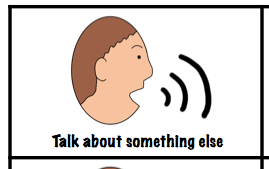So in my last post I talked about why people perseverate. Let’s face it, we all do it. We just (sometimes) know what situations it is appropriate for. Our students often don’t. So, what can you do to address verbal perseverations? I want to share 4 strategies that can be used effectively as well as some examples and then I have two freebies for you to try. Clearly which strategy you try will depend on the function of the behavior, as I talked about last time, as well as what works for you, the student, and the situation.
1. Ignore the statement if you have already responded to it
Yes, ignoring is easier said than done. In fact in a survey by the University of South Florida years ago, they asked parents about whether their children showed problem behavior and whether they received enough support around those behaviors. Interestingly the parents indicated that yes, their children showed problem behaviors but the ones they were most frustrated by and felt they had the least support for were repetitive behaviors like perseverations. Parents reported that having to listen to the same song or hear about the same topic repeatedly for days on end was the most significant problem they dealt with because they felt they had support from professionals for the aggression and self-injury. So, you aren’t alone. These types of behaviors get to all of us (professionals and families). An easy strategy is to respond once or twice to the individual’s statement and then try to redirect to something else to do. Always redirect to something, rather than just asking them to stop talking about that one thing.
2. Redirect with a visual to talk about something else or to a relaxation strategy
If ignoring just isn’t going to cut it, and especially if the behavior is tied to having difficulty finding a topic to talk about to get attention, try using a visual to redirect the person to talk about something else. For instance, if a child can only talk about Toy Story, show a visual that says, “Talk about another movie” or “I want to talk about something else.” I suggest using a visual because it keeps you from attending verbally to the behavior and because the individual can’t argue with the visual. Think of it as a polite way to make your eye rolling or other more subtle facial expression at the 15th time you have talked about Minecraft today more clear to the individual. You are giving information about what he or she should do instead. You can use a picture or write out the words as a way to redirect, but the picture is a tangible item that you can leave behind when you walk away from the conversation if he or she continues to perseverate.
You can also redirect to a calming strategy to try to relieve anxiety if you think that is a possible function of the perseveration. For instance, if your student has talked about going to the dentist 20 times today, perhaps it is because he is anxious about it. This would be a good time to use a visual that says, “take 3 deep breaths” or “squeeze some putty.” Some good visuals for this can be found in my anxiety post on A Special Sparkle.
3. Direct the student to his / her schedule with a time he can talk about the topic
Schedule a time that the student can talk about his or her favorite topic and then put that time on his or her visual schedule. This way, he or she learns to talk about it at an appropriate time and you can use the schedule to redirect (e.g., “When can we talk about Minecraft? Check your schedule. OK, we have to wait for pack-up time for that then.”). Now clearly if this doesn’t work you have to ignore and continue to redirect by pointing to the schedule, but you know that there is a time when he or she can talk about it and that you have given him or her the information about it. I had a colleague who had a group of students who all used to talk about Power Rangers constantly. Rather than constantly fighting it, she scheduled a time at the end of the day and put it on the calendar that the class could talk about their favorite topics. She then used that time to write her homenotes while they talked to each other about their perseverations. Whenever they talked about it at other times, she told them to check their schedules and they quickly learned when it was allowed. You can also reinforce following those redirections to help them be successful at first.
4. Set a Limit in a Concrete Way
Finally, this is probably my favorite way of handling verbal perseverations. Set a limit. It could be a time limit with a timer. He could have 5 minutes to talk about something that interests him and when the timer goes off it’s time to move on.
If you have a student who really likes lists or likes checking things off lists, use a list of people he or she can talk to about the topic. Then each time he talks about Minecraft with a person, he has to cross that person off his list. So, if he comes up to me to talk about Minecraft, I would direct him to look at his list. If he has already talked to me about it today, and my name is crossed off, then he has to either talk to someone else he hasn’t talked about it with today or talk to me about something else. And after all, isn’t that what we do when we really want to talk to someone? We just read social signals better.
 Another option is to give the student a set of tickets with the number of times he can talk about his favorite topic. For instance, if he has 5 tickets to talk about movies, he has to give up a ticket each time he does. If he can’t give me a ticket because he ran out, he has to talk about something else.
Another option is to give the student a set of tickets with the number of times he can talk about his favorite topic. For instance, if he has 5 tickets to talk about movies, he has to give up a ticket each time he does. If he can’t give me a ticket because he ran out, he has to talk about something else.
With all of these options it’s important to make sure that you are teaching alternative topics of conversation and possibly anxiety-reducing strategies to replace the perseveration. But while those are being taught, these are strategies that can help address the behavior. And to help you try them, I have included 2 freebies. First, you can download the redirection visuals above. Download it here. Then, you can also download a set of editable talk tickets for which you can fill-in the topic of perseveration for the individual student. You can download the PowerPoint file here.
What strategies do you use to manage verbal perseveration in your classroom? Please share in the comments. The more ideas we have the more effective everyone can be for our students.
Until next time.












